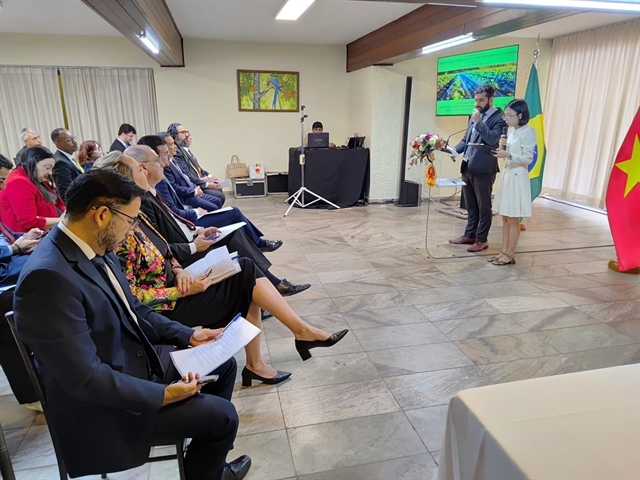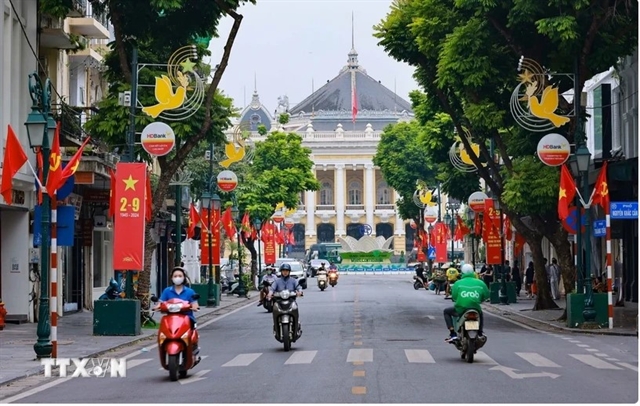 Economy
Economy

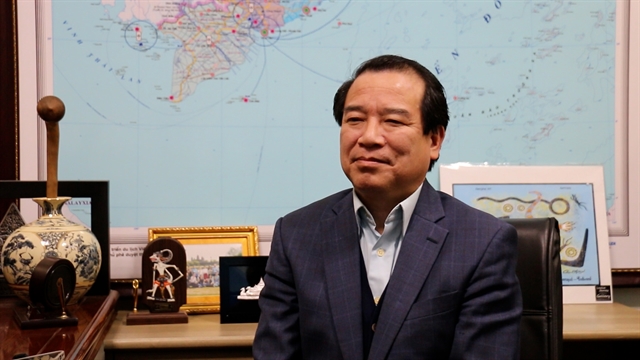 |
| Hà Văn Siêu, deputy director general of the Việt Nam National Authority of Tourism. —VNS Photo Nhật Hồng |
Deputy Director General of the Việt Nam National Authority of Tourism under the Ministry of Culture, Sports and Tourism, Hà Văn Siêu, spoke with Việt Nam News’ reporter Nguyễn Hằng about the notable strides that Việt Nam’s tourism industry has made, particularly in attracting international visitors in 2024, as well as plans for the sector in 2025.
What are the key achievements of Việt Nam’s tourism industry in 2024? How do these compare to 2023?
The year 2024 marks an important milestone for Việt Nam’s tourism sector as it has fully recovered to pre-pandemic levels. The country is forecast to welcome between 17 and 18 million international visitors in 2024. Meanwhile, domestic tourism now has surpassed 110 million visitors.
Tourism revenues have exceeded VNĐ884 trillion (US$34.6 billion), surpassing figures from 2019 – the time before COVID. Thus, the achievements of Vietnamese tourism in welcoming guests, as well as reopening and restoring all tourism activities across the country, have been realised.
The most remarkable achievement is the return of international tourists to Việt Nam. The tourism sector is growing rapidly, contributing to economic development, improving the image of the country as a destination and generating employment opportunities. All tourism activities that were suspended during the pandemic have now fully resumed. The tourism sector has created a strong foundation for future growth.
Compared to 2023, 2024 has seen a clear shift from focusing on volume, to emphasising quality and sustainability. The experience of visitors is now at the heart of tourism development, with high-quality service becoming a key factor for ensuring the sustainability and effectiveness of the sector. Tourism not only brings joy and happiness to visitors but also benefits local communities and businesses.
 |
| Foreign tourists visit Ngọc Sơn Temple in Hà Nội.— VNA/VNS Photo Thanh Tùng |
Statistics showed that Việt Nam welcomed more than 15.8 million international visitors by November 2024, a 41 per cent increase from the previous year. How were those results achieved?
By November 2024, Việt Nam had welcomed 15.8 million international visitors, with December expected to be a peak month for international arrivals. The country is on track to meet its target of 17-18 million visitors by the end of the year.
These achievements are the result of collective efforts across the tourism industry, particularly from businesses, local administration and the Ministry of Culture, Sports and Tourism. Efforts in promoting Việt Nam as a safe, friendly and welcoming destination have been key to that success.
Thanks to promotional activities, visa policies and the involvement of businesses and local authorities, the recovery of international tourism has been rapid. The number of international visitors in 2024 has surpassed 2023 by 41 per cent.
Tourist destinations and tourism activities have become vibrant again. Services are increasingly diverse with many new tourist destinations and many new tourism products. Post-pandemic, the quality of Việt Nam’s tourism offerings has significantly improved, with tourists staying longer and engaging in deeper, more immersive experiences.
New tourism products, such as railway tours, food tours, nature exploration tours and experiences that highlight local cultural heritage and health-focused tourism, have emerged.
The new products have made high mountainous areas in Hà Giang Province, Sa Pa Town (Lào Cai Province), Sơn La Province and Central Highlands region, popular destinations for both domestic and international tourists. Young people, in particular, are increasingly seeking authentic experiences in rural, mountainous and eco-tourism regions.
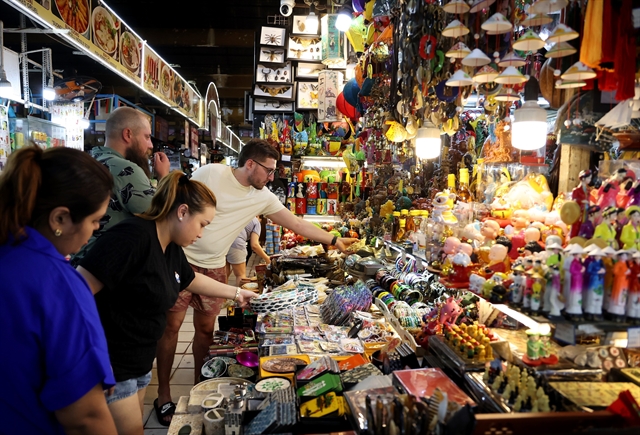 |
| Tourists at Bến Thành Market in HCM City..— VNA/VNS Photo Hồng Đạt |
It is estimated that Asia contributes nearly 80 per cent of Việt Nam’s international visitors, with the markets of China, South Korea, Taiwan (China) and Japan accounting for almost 60 per cent. European markets, including the UK, France and Germany, are also showing significant growth. What policies will the tourism sector implement in 2025 to maintain the markets and attract new ones?
Việt Nam is now considered the heart of Asia. Markets in the northeast of Asia, such as Japan, China, South Korea and Taiwan (China), make up 60 per cent of the international arrivals, reflecting Việt Nam’s strong position in the culturally close markets. The success is the result of a well-defined strategy of Việt Nam's tourism sector.
Looking ahead, Việt Nam plans to further diversify its tourism markets, with India emerging as a promising new source of visitors. Additionally, Australia and Middle Eastern markets are also being targeted.
A strategic focus will be on attracting tourists who have a genuine affinity for Việt Nam, those who appreciate the country's culture, cuisine, landscapes and, notably, golf tourism. Việt Nam now has been recognised as the best golf destination in Asia for eight consecutive years.
The goal is to create lasting impressions that will encourage repeat visits. Việt Nam’s tourism strategy will continue to prioritise creating long-term relationships with visitors, ensuring they spend more time and money during their visits, especially by cultivating a loyal, return-visiting market.
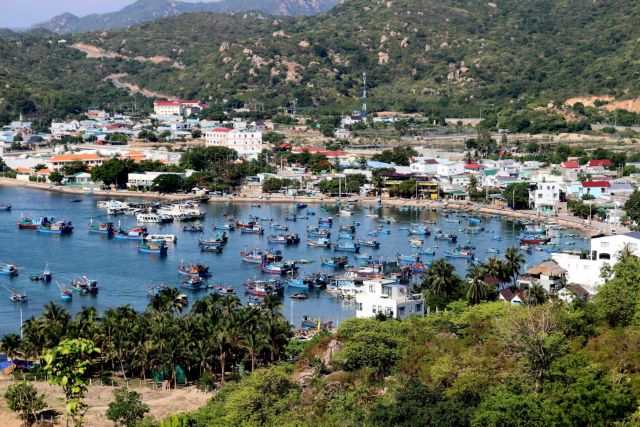 |
| Vĩnh Hy tourist village in the coastal south-central province of Ninh Thuận. — VNA/VNS Photo Nguyễn Thành |
Could you share the plans for promoting Vietnamese tourism in 2025? The coastal central province of Thừa Thiên-Huế will host the National Tourism Year in 2025. What positive impacts will this have on both the local and national levels?
Promotional efforts remain a central task for the Việt Nam’s tourism sector. The goal is to attract a growing number of tourists, particularly high-quality visitors, by presenting Việt Nam as a safe, friendly and attractive destination.
In 2025, the focus will continue on the successful initiatives of 2024, with a deeper emphasis on cultural heritage and quality experiences. The National Tourism Year, organised in Thừa Thiên-Huế Province, will highlight the province’s rich cultural heritage, especially its status as a former royal capital.
The province is an extremely special destination in terms of cultural heritage. We need to exploit that theme in order to exploit high-quality tourist flows from regions such as Europe, North America, Australia or even Northeast Asia, so that the province becomes a prominent destination in 2025.
Huế City’s status as a centrally-administered city in 2025 will present significant opportunities for the locality. The local administration, residents, along with national tourism authorities, are working to build Huế City’s reputation as a prominent destination both within Việt Nam and internationally.
Key activities during the National Tourism Year in 2025 will include a global conference on cultural industry, which will stimulate the development of Việt Nam’s cultural sector. Additionally, there will be a strong emphasis on sports tourism, including a global golf tourism conference in May 2025 in the province.
The National Tourism Year in 2025 will also focus on the intersection of food, heritage and sports tourism, with the province serving as a central hub for the themes, enhancing Việt Nam’s international profile.
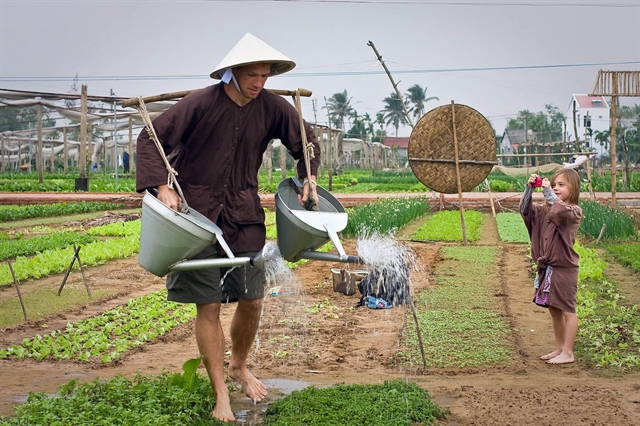 |
| Foreign tourists try their hands at watering a garden in a traditional way at Trà Quế vegetable village in the coastal central province of Quảng Nam. — VNA/VNS Photo |
Nowadays, sustainable tourism and green tourism are common trends across the globe. How does Việt Nam plan to develop these?
Green and sustainable tourism are prominent trends in the world, also one of the directions that the United Nations Tourism Organisation has oriented for member countries. On December 9-11, 2024, Việt Nam hosted the Global Conference on Rural Tourism. There, the United Nations Tourism Organisation emphasised that tourism based on indigenous cultural values, ecological values of rural areas and agriculture will become increasingly prominent.
Tourism in Việt Nam will focus on the ecological and agricultural values of Việt Nam and the cultural identity of Việt Nam to become an outstanding product, competitive with the region and the world. Green tourism aims at sustainable values across all pillars, the economy, culture and the environment. But the special thing is culture to consider the human factor as the centre, promoting the value of indigenous culture and community livelihoods.
The aim is to ensure that tourism not only brings economic benefits, but also respects cultural and environmental sustainability. Local communities should benefit from tourism. Tourism should create prosperity, well-being and happiness for all.
Việt Nam has already made strides in green tourism and sustainable tourism, with the Trà Quế vegetable village being recognised as one of the best rural tourism destinations in 2024. Across the country, there are numerous examples of destinations embracing green tourism principles, with more businesses adopting sustainability criteria and applying net zero practices.
We believe that Vietnamese tourism sector, moving towards greener and sustainable practices, will reap many rewards and meet the expectations of tourists around the world who come to Việt Nam, seeking authentic, eco-friendly and sustainable travel experiences. — VNS




